The German Spitz as Shepherd Dog
Watchdog, mouse hunter, nanny - and he is also able to drive the cattle!
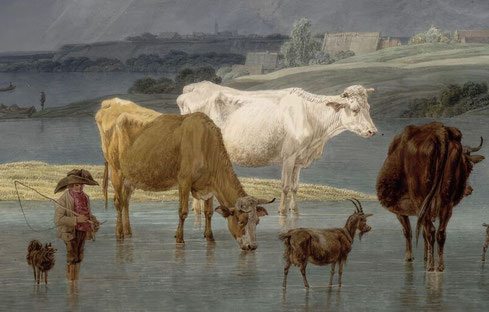
What, the Spitz now also a shepherd dog? Yes! If we go back in history, we quickly realize that people used to have just one dog for several tasks because most people couldn't afford more than one dog. And this dog not only had to protect the belongings of his owner, kill rats, mice and vermin and keep an eye on the master's children, but also guard the livestock and, if necessary, defend them. The Spitz was of course predestined for this because he can basically do everything - except fly, whistle and eat with a knife and fork. 😜
The Spitz, as an old rural breed and dog of the common people, has always been a weatherproof, very frugal and at the same time clever and easy to train all-rounder:
“If the farmer had to devote as much time and effort to training as the modern dressage books prescribe, then the dog would not be a help to him, but a new burden.” [1]
It is not without reason that farmers often find out that one Wolfspitz replaces several dogs. It was only over time that dogs were bred for a wide variety of tasks - specialists emerged. However, this specialization into certain tasks came relatively late and was typically reserved for the rich bourgeoisie and nobility of England. For this reason, there are hardly any written or visual documents about the old farm dogs. Who draws the farmer with his dog? Certainly not the painter who had to make a living from his work.
The shepherd dogs
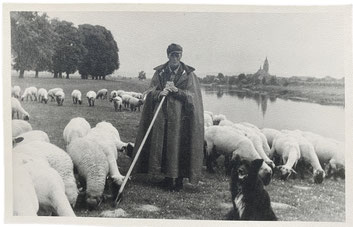
The headline “The German Spitz as Shepherd Dog” is admittedly rather colloquial. I chose it because it is easier for the layperson to understand than the correct name for his activity. This is called "cattle dog" - because there is a considerable difference between a dog that herds sheep and a dog that drives the cattle.
There are basically two types of dogs that are used to work on livestock herds: One type has the primary task of protecting the herds and driving away predators; today they are known as “Livestock Guardian Dogs”.
The other type serves to support the shepherd and is divided into three subtypes: the subtype of “sheepdogs” circles around the livestock and acts as a kind of living fence, the subtype of “cattle dogs” drives the animals from behind from place A to place B, while the "paddock dogs" (maybe not the right title, I just translateted it from German) collect individual animals or the entire herd and bring them to the shepherd.
What exactly do sheepdogs do?

Sheepdog is actually a generic term for the work that these breeds do. They are also called “furrow runner”; the dogs draw an invisible boundary (“furrow”) between pasture and neighboring land, for example to prevent the herd from destroying the crops on the neighboring property. The sheepdog basically acts as a living fence and keeps the animals together. The sheepdog basically acts as a living fence and keeps the animals together. If the shepherd wants to move on, he calls one of the leader sheep of the herd and moves on, while the dogs continue to secure pasture boundaries or crossings.
The work of sheepdogs is based on the territorial drive, which is all about defending boundaries. They can also defend their flock on the orders of the shepherd. Or, if necessary, the shepherd, since the shepherd's profession was one of the so-called "dishonest" trades until early modern times.
The sheepdogs' main use - as the name implies - is with larger, homogeneous flocks of sheep. They help the shepherd to hold them together and ensure that none of the animals get lost. They are also called “herd working dogs”.
Since the sheepdogs tirelessly patrol up and down these "invisible" borders and inevitably cover long distances, they were bred with the aim of having high endurance and low energy consumption. The following sheepdogs are used: German Shepherd Dogs (East German breeds, no show cripples) and Old German Shepherd Dogs.
And paddock dogs?

While the sheepdogs work out of territorial behavior, the "herding" of the paddock dogs is nothing other than a modified prey drive. While “grabbing and killing” prey has been bred away, herding behavior is characterized primarily by encircling, stalking and fixing the herd.
Their work consists of collecting the cattle from the pasture and driving them to fresh pasture. They are also important helpers when working in the pen (e.g. when trimming their hooves or shearing sheep). Paddock dogs have the ability to espy farm animals over long distances, walk around them, and then bring them to them independently or under the specific guidance of the shepherd. They usually work silently and can move both individual animals and herds of several hundred animals. The mostly short work assignments with precise instructions from the animal owner require the dogs to be very flexible and obedient, so that they can be controlled by the shepherd almost like drones, even from a distance. Breeds that are traditionally used as paddock dogs include the Border Collie, the Australian Shepherd and the Working Kelpie.
Cattle dogs aka "Cow Dogs"

In contrast to the sheepdogs, the cattle dogs have a much stronger assertiveness and also a strong protective and territorial instinct, which is much less pronounced in the sheepdogs.
Their area of responsibility lies in the proverbial “driving”, but also in protecting the livestock, mostly cattle and cows. Cows are much more self-confident than sheep and would not be moved to do anything by just staring at them - as the Border Collie uses to move the animals. Except maybe rolling on the floor laughing. 😆 That's why cattle dogs used to be called "Cow Dogs".
When driving, the dogs move behind or to the sides of the herd, and often go into the herd if necessary. To work as a cattle dog, you need strong, agile, courageous and defensive dogs who can apply pressure without too much stress, who can avoid the animals' kicks and horn blasts and can drive them with barking or targeted hoe bites.
The predisposition to herding - in contrast to sheepdogs - does not arise from the hunting drive, but from the territorial instinct, which also ensures a high level of alertness and a certain "sensitivity to stimuli" in dogs with this disposition. Cattle dogs are also relatively independent dogs; you won't find absolute obedience. Cattle dogs can therefore usually only be controlled with moderate precision.
The work of the cattle dog is physically much more relaxed than that of the sheepdog: in complete calm, he lies or stands near the herd until finally the call or wave of the shepherd (or his own initiative) causes him to drive an animal in order to finish his work to relax again. This is also reflected in the cattle dog's different body structure than that of a sheepdog, as it is much stockier. Classic cattle dog breeds are: Australian Cattle Dog, Harzer Fuchs and Westerwald Kuhhund. And - even if forgotten - the German Spitz.
The German Spitz in the service of the herds

We now know that different dog breeds have been bred for different types of livestock work: those that are specialized in herding and those that are better at driving livestock. There are also German breeds that are used in a variety of ways by moving, controlling and protecting the herd together with the shepherd. And our German Spitz was and is one of those:
"In some areas of Germany the Spitz was used for this purpose, and in Upper Saxony the Pommer was used. [4] They governed and protected the herd and kept it in order." [5 ]
For this task, the so-called “heel bite” is already innate in the Spitz, which occurs silently and deeply into the dry leg (into the pastern). A correctly done hoe bite is completely harmless to the animal, does not bleed and does not hurt. What is important, however, is that the dog's bite really has to be done in the right way; simply biting into anything is wrong. For example, if a bad cattle dog grabs the thigh of a cow, bloody wounds could result if the bite was too sharp, or hematomas if the bite was too lax. If the bite was not close enough, the dog would only get hold of the wool or fur and tear it out. Of course, none of this is productive.
In the magazine of the German Spitz Club, no. 63 you can read the following about the suitability of the Wolfspitz as a cattle dog:
“[...] Examples and tests have proven the Wolfspitz's excellent suitability as a cattle dog. With astonishing certainty he finds lost cattle, herds them into the milking place, arranges for them to be taken care of, and drives them on the road. He pushes the cattle as much as possible with his muzzle without grabbing it. The Wolfspitz even gets so far that he is able to safely guard, lead, drive out and lead the herd entrusted to him back home, even without humans. Today, our “Gray” is only rarely used as a shepherd dog. It would truly be a laudable and grateful task to recognize him again in this professional field.” [6 ]
Spitz, you hoe-biter!

Why does the Spitz actually need the heel bite? Herds of sheep can be impressed and guided by a bit of noise, but things are a little different with cattle. The dog has to be more careful with them, because a herd of 50 to 100 cattle is not at all easy to manage.
In the past, sheepdogs that bit sharply (bloodily) often had their fangs filed down so that they could not injure the sheep. A dog with filed teeth, on the other hand, couldn't do anything with a herd of cattle. Cattle are often quite stubborn, and some animals actually require a lot of courage and strength from the dog before they move. An old saying goes: "If a herd of cattle has no respect for the dog, the shepherd's afternoon nap is over forever. "
Pigs are also quite stubborn and defensive, but unlike cattle, the dog does not grab them by the heel, but rather by the ear, so as not to injure the ham. However, the dog must be taught to grab the ears: you lead the muzzled dog towards the pig. The dog walks along the side of the pig without being able to grab anything until he gets to an ear. This fits through the spaces in the wire basket and can now be grabbed by the dog. [8]
Miley drives a big turkey: The Mittel Spitz bitch "Miley", who was only 6 months old at the time the photos were taken, on her first meeting with a turkey who knows dogs, but is not completely easy to handle. Miley knew from her daily routine that the turkey should go into the stable. Image A: Miley is still clumsy and makes a request to play in her distress. The turkey threatens her, but she is not afraid. Image B: Miley turns the turkey by blocking him. Image C: The turkey avoids and shows clear displeasure. But Miley sticks with it and is praised for it. Image D: The turkey runs towards the stable and Miley stays calmly behind him. As soon as she lets up, he turns - but she doesn't give him this option. (Text and photos, with kind approval by Birgit Kaiser)
It must be emphasized at this point that the cattle dogs do not bite the cattle for their personal pleasure, but to do their duty. Otherwise, they live on good terms with their herd. It is often observed that there is a friendship between the dog and the herd; they lick each other or the dog plays with the young animals. If an animal is sick and cannot follow the herd, the dog becomes worried and does not leave the sick animal. He knows every single animal in his herd.
What must a Spitz be like in the service of the herds?

First things first: The shepherd dog must be able to carry out his duties without having to learn the skills - they must necessarily be innate to it. This is the case with the Spitz because he knows how to drive both sheep and cattle. The Spitz seems to know the difference between the two types of livestock, because he works on them using two different methods: With the more sensitive sheep, he looks to shoulder barge or muzzle punch them in the wool essentially to not injure their sensitive skin. As for the cattle: here he loves the conflict with the cattle and loves to use the innate heel bite as well as the zigzagging when facing the animal head-on.
His senses of smell and hearing are very well-developed, as it is not uncommon for the dogs to drive the herd to the pasture and back independently. I have also read several times that shepherd dogs have almond eyes because with them, they can see particularly far. Ernst Floeßel reports:
"Just recently, a city shepherd told me that he had built a house and did the work alone, while the dog looked after the livestock independently all summer long. [...] Only a shepherd dog can do this, because his almond-shaped eye is very far-sighted, and so he can still communicate with his master at a distance of 600 to 800 m." [9 ]
A more recent example describes very clearly that the German Spitz is actually able to drive the cattle independently and without support from humans: "By barking and nipping, she (the Wolfspitz bitch, author's note) ensures that the cows always follow one another and don't digress. She knows exactly the times. She is sent from the house to fetch the cows so that they can be milked. Furthermore, she watches over them during milking and after milking she leads them back to the pasture." [10 ]
Furthermore, the herding dog walks on cat's paws and must have a medium-long neck. The neck must not be too short because the dog has to make half a turn with it when biting the hoe. This is why dogs with short necks are bad biters. This is of course a real problem when dealing with stubborn, defensive cattle and pigs.

White dogs were consistently preferred as shepherd dogs because they can be easily distinguished from wolves even at dusk or dawn. Nevertheless, all other colors were also used for the service of the herd, as can be clearly seen in the paintings by Wilhelm von Kobell and in my own historical photos.
The dense ruff around the neck, which we find in the Spitz, is essentially the equivalent of the collar with outward-pointing spikes, which has served as protection for many livestock guard dogs from bites by wolves.
As far as the character of the shepherd dog is concerned, it is very important that he has no hunting instinct. A bad dog has always been called the one about whom the shepherd had to say: "Saved from the mouth, not of the wolf, but of the dog."
So that the dogs didn't get a taste for the cattle - in the truest sense of the word - they were fed very generously, but received relatively little meat. It used to be assumed that a lot of meat made dogs kind of "meat-hungry". For these reasons, feeding raw meat was also strictly avoided.
An old saying goes: "When the dog is awake, the shepherd may sleep; but when the dog sleeps, the wolf is good at stealing sheep." Accordingly, it is very important for a good shepherd dog to be really, really alert. Almost always on point, just like the Spitz is always on point. Furthermore, he must be strong, agile, defensive, courageous and independent in order to be able to show the cattle who is boss in the ring.
Spitz, Hütespitz, Schäferspitz and Schäferhund: Huh?

Researching the origin of the German Spitz and his various styles is difficult because you can find almost nothing on the subject, and these few sources often contradict each other. My current state of knowledge is (conditional) as follows:
For a long time, large Spitz dogs and Schäferhunde (German Shepherd Dogs) were not really differentiated from one another, as the transitions between the two types at that time were fluid. This is illustrated not least by the names “Hütespitz” (Herding Spitz) and “Schäferspitz” (Shepherd Spitz). The old term “Wolfhund” (Wolfdog) used to describe both Shepherd Dogs and Wolfspitzes.
Of all the Spitz forms, the Wolfspitz is probably the basic form, which has certainly been helping farmers in his familiar form for centuries (or millennia). Wolfspitzes have something primal and impressive and are far more reminiscent of wild canids than the large, medium and small Spitz in terms of their fur color and skull shape. The Wolfspitz is also even closer to the German Shepherd than the other Spitz varieties are:
"[...] while the actual German Shepherd more closely resembles the large Spitz, with his intelligent face that looks like a wolf and fox in one picture." [12 ]
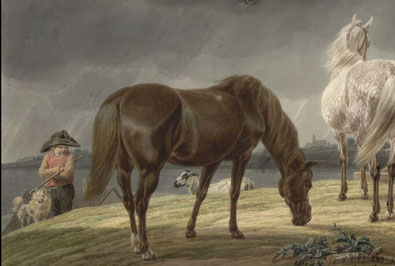
Kynophilos Actaenon also sorts the Spitz and the German Shepherds together into one breed in his 1781 book “Detailed History of Dogs”: "Shepherd dog, Spitz or Schäferhund as the ancestor.”
The Schäferspitz or Hütespitz of the past was described as follows:
"Dogs with long hair and a stand-off ruff on the neck, head and feet with short hair, legs and tails with feathered hair, the curled tail carried over the back, color predominantly white, also wolf-colored, fox-colored; it is the smallest species and undeniably with the Spitz related, white color most common, size 50–60 cm." [13 ]
Definitely a Spitz that is described there, but larger than the classic Spitz of old times, which was usually around 40–45 cm tall. However, Wilhelm von Kobell's numerous depictions of Spitzes in herding situations also often show dogs that are at most medium.
The fact that the German Spitz was actually generally known as a shepherd dog is also evident from an old text about fashion dog breeds, in which it is described how the Spitz once became a trendy lapdog for a short time: The group Maltese dogs had to give way to the white Spitz as a fashion dog "who, however, did not give up his dignity as a shepherd dog, but on the contrary saw himself exalted since he became a lapdog." [14 ] After a short period of fame, the Spitz was replaced by the Pug as the ladies' favorite.
The Spitz as root form
The German Spitz is the original breed of dog in Northern and Central Europe. They were and are the extremely versatile dogs of the farmer and the little man who could only afford one dog. What's exciting is that the Spitz is one of the original/ root forms of our dog breeds, which are:
- Molossians,
- Poodles,
- Hounds,
- Greyhounds,
- and just German Spitzes.
All (!) other dog breeds are made up of these root forms. However, it is impossible to breed the root forms in their entire perfection from these hybrid forms. At best, superficial similarities are achieved.
What can be derived from this? The hallmark of the closed character of the German Spitz as a root form is based absolutely on keeping away any crossing. This is the only way to keep the Spitz as versatile, reliable and hard-working as we have always known and appreciated him. That's why the cross-breeding of foreign breeds, which is so often the case with the Spitz, is about the stupidest thing you can do to preserve him, because exactly the opposite is the case.
The Spitz as the basis of today's shepherd dog breeds
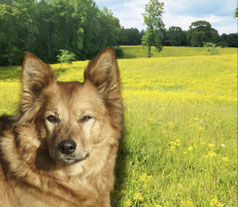
But what has always been popular is to breed new breeds from the original Spitz breed. And because the Spitz is not only a great guardian, but also knows how to handle the livestock, he became the ancestor for many sheepdog and shepherd dog breeds, such as:
- Harz fox,
- Corgi,
- Bordercollie,
- Australian Shepherd,
- Sheltie,
- Appenzeller Mountain Dog and many more.
What working as a cattle dog says about character and training of the German Spitz

It is exciting to draw the circular conclusion from the suitability of the German Spitz as a cattle dog to his trainability: In most breed descriptions that can be found on the Internet, the Spitz is described as easy to train and absolutely suitable for beginners. I have already commented in several places about how wrong I find such stereotypes. Because it's simply not true - and because it's not without reason that many half-grown Spitz end up in animal shelters.
The fact that the Spitzes were also used as reliable cattle dogs shows crystal clear what kind of dog character we are dealing with here. Here we have a breed that with great courage goes into the middle of a herd of cattle and shows them who's the boss. Even at the risk of getting kicked by a less cooperative cow. Many owners of such a dog have to find out for themselves sooner or later that a dog that has to chase after the cow has actually kicked him is not necessarily impressed by a nice person with a bag of treats. By his nature, the German Spitz cannot be obedient, but is an independent, self-confident and thoroughly defensive fellow.
A dog also needs an extremely high willingness to bond in order to remain focused on his human, even over long distances. This willingness to bond together with a great deal of self-confidence results in the ability to work independently, as shown by the German Spitz (by the way, selecting or breeding for these characteristics is not easy). Of course, a dog like this wants to be taken seriously by his people, but still wants to know his appropriate place in the family.
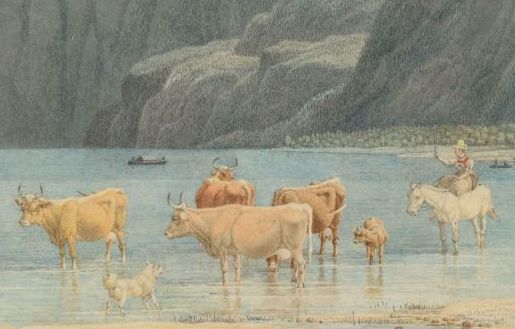
Nowadays, however, most dog owners primarily focus on the needs of their pet. Let's take a look at how the shepherd trains his dogs:
Above all, the shepherd needs a helper who is generally able to remain calm, but is wide awake and ready for action on command. He has no use for a dog that constantly runs around preventing the livestock from eating, that chases after every rabbit, or that harasses hikers who pass by the herd.
For this reason, nothing is done to the young dog in the first year of life. Absolutely nothing. The only thing the youngster does is watch the shepherd and the other dogs at work. Above all, he learns to react calmly to external stimuli and to be able to differentiate between them.
And what does the layman do? Run with the young Spitz to puppy school, where the dog learns how to fight and other BS, or he encourages the young dog's instinct to play with the help of balls, ropes and other throwing objects - because playing together is oh so important. The only thing that is encouraged here, however, is prey drive (yes, even with Spitzes). As a result, the Spitz may at some point react to every movement, whether it's a passing car, cyclist, cat or running child. Often with dramatic consequences for the dog, as such behavior usually results in lifelong leash-imprisonment. So while it is unlikely that there is a shepherd anywhere who would have problems with the hunting behavior of his dogs, it is precisely this problem that is driving more and more "hobby dog owners" to dog schools.
Conclusion: Above all, a German Spitz needs to learn to be calm and for that he doesn't necessarily need agility, man trailing or rescue dog work. Especially not when he's not fully grown yet. It's actually quite simple: a Spitz wants to help you with something, but he doesn't care with what. This can also be the simple but valuable walk together, accompanying someone on a shopping trip or visiting a café.
Border Collies in action as cattle dogs and the final words

There is an old saying that goes, "The prophet is worth nothing in his fatherland." And that’s exactly what happens to our German Spitz. Although he is our oldest domestic dog breed and an all-rounder that couldn't be better, people often rely on breeds that are currently more trendy - be it for guarding the house or for herding the flock. So people try to herd their cattle with Border Collies and then complain in online forums that somehow it doesn't work so well.
Even the GEH (German society for the preservation of old and endangered domestic breeds) knows nothing about the German Spitz's suitability as a cattle dog. The following can be read about the Altdeutscher Hütehund breed (Old German Shepherd Dog) on their homepage:
"The only German dog breed that can cope with difficult herds of cattle."
Nope! ✋🏻 I have to strongly disagree here. The German Spitz is also able to drive herds of cattle. And he should be allowed to do that a lot more often!
Unfortunately, the Spitz's many abilities have always been overlooked and, even as a shepherd dog, he has always fallen behind, which has led to a certain resignation among Spitz friends of all times. A shepherd in Upper Lusatia, Saxony, once called said to his Spitz in church "Spitz come on, we'll leave, the Karl taunts" when the priest was preaching about the good shepherd. 😉
To avoid any complaining: I am neither a shepherd, nor does this article aim to explain shepherding to anyone. My only aim is to simply explain that the German Spitz is also suitable for working as a cattle dog - nothing more and nothing less!
[1] Quote by cynologist Rudolf Löns
[2] https://pixabay.com/de/users/varadannadate-20833347/
[3] By Jean-Michel Castelan/Design Madeleine - Collection privée, CC BY-SA 3.0, https://commons.wikimedia.org/w/index.php?curid=3855094
[4] With „Pommer“ only the white Spitz is meant.
[5] Ernst Floeßel - „Der Hund – Ein Mitarbeiter an den Werken der Menschen“, p. 225
[6] From: „Der Deutsche Spitz“ no. 63, p. 48
[8] Floeßel, p. 232
[9] Floeßel, p. 232
[10] From: "Der Tierfreund" 9/1965
[11] By friend of tr:user:Onur1991 - Commons file "KangalTürkiyede.jpg", CC BY-SA 3.0, https://commons.wikimedia.org/w/index.php?curid=16984761
[12] Floeßel, p. 235
[13] Floeßel, p. 230
[14] See. Floeßel, p. 384
[15] https://www.dogbible.com/de/hunderassen/harzer-fuchs
[16] © Deutsche Fotothek/ Regine Richter; Kupferstich: Dresden, Staatliche Kunstsammlungen Dresden (SKD), Kupferstichkabinett
29.02.2024








